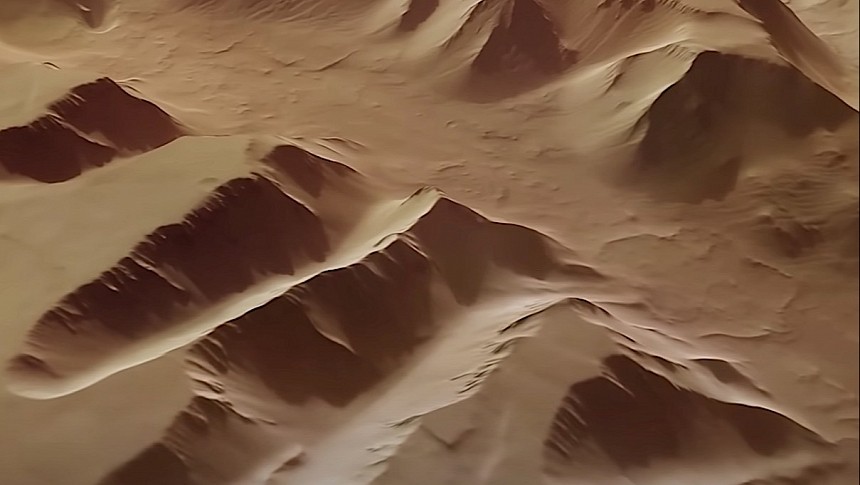They call the place Noctis Labyrinthus (night’s labyrinth). It's a location over on Mars where deep valleys with huge, steep walls play a hide-and-seek game with one another to create a sight very difficult to see anywhere else in the solar system. Do you find that hard to believe? Just have a close look at the video attached below this text.
Noctis Labyrinthus is how humans have called this extraordinary planetary feature located smack down between two other unique planetary features: the largest canyon in the solar system, Valles Marineris, and the tallest volcanos anywhere in Sol, the ones in Mars' Tharsis region.
The area is about 1,190 km long (739 miles) and it is believed to have been formed back when the neighboring volcanic region was still active. Under the immense pressure exercised by volcanoes, the planet's crust arched upwards, stressed, and thinned out until it eventually subsided.
Humans have known of the Labyrinthus' existence for a long time, and scientists find it particularly interesting because the faults allows them a closer look into the planet's past, through the layers of soil visible in the steep walls.
The place is so important that over the years some missions have even been sent over it for a closer look, including the HiRISE. One of the most recent is the European Mars Express, orbiting the planet since 2003, and which is also responsible for the video below coming to life.
Using images the spaceship's High Resolution Stereo Camera (HRSC) captured over the years, the European Space Agency (ESA) is now able to show the world "a perspective view down and across" of one of the most imposing natural features we know of.
The images show the eastern part of the area, revealing anything from plateaus (which were once the planet's original surface level), to large canyons and valleys. Some of the canyons are so big that they can stretch for as much as 30 km (19 miles) wide and six km (four miles) deep.
Such differences in size compared to surface levels have created in some areas to enormous landslides, while elsewhere some walls of these many canyons have become sand traps and started being filled by dunes.
The video before us has been put together using Mars Express images and a digital terrain model with topographic information, with every second of the almost four-minute-long video showing 50 separate frames. And although it is just a CGI clip, it does manage to give us a sense of just impressive Mars is in some respects.
Because of its physical makeup, Noctis Labyrinthus is probably not a place humans will want to settle once they reach Mars, but it's very likely sometime in the distant future it will become a major tourist attraction for the people of Sol.
The area is about 1,190 km long (739 miles) and it is believed to have been formed back when the neighboring volcanic region was still active. Under the immense pressure exercised by volcanoes, the planet's crust arched upwards, stressed, and thinned out until it eventually subsided.
Humans have known of the Labyrinthus' existence for a long time, and scientists find it particularly interesting because the faults allows them a closer look into the planet's past, through the layers of soil visible in the steep walls.
The place is so important that over the years some missions have even been sent over it for a closer look, including the HiRISE. One of the most recent is the European Mars Express, orbiting the planet since 2003, and which is also responsible for the video below coming to life.
Using images the spaceship's High Resolution Stereo Camera (HRSC) captured over the years, the European Space Agency (ESA) is now able to show the world "a perspective view down and across" of one of the most imposing natural features we know of.
The images show the eastern part of the area, revealing anything from plateaus (which were once the planet's original surface level), to large canyons and valleys. Some of the canyons are so big that they can stretch for as much as 30 km (19 miles) wide and six km (four miles) deep.
Such differences in size compared to surface levels have created in some areas to enormous landslides, while elsewhere some walls of these many canyons have become sand traps and started being filled by dunes.
The video before us has been put together using Mars Express images and a digital terrain model with topographic information, with every second of the almost four-minute-long video showing 50 separate frames. And although it is just a CGI clip, it does manage to give us a sense of just impressive Mars is in some respects.
Because of its physical makeup, Noctis Labyrinthus is probably not a place humans will want to settle once they reach Mars, but it's very likely sometime in the distant future it will become a major tourist attraction for the people of Sol.













